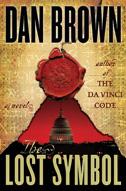The Lost Symbol, by Dan Brown '86
 The Lost Symbol is published by Doubleday |
Reviewed by Rand Richards Cooper ’80
Dan Brown ’86 isn’t a writer—he’s a publishing tsunami. Our local Borders store currently features a gigantic Dan Brown altar, where the faithful line up to receive not only multiple trade and mass-market editions of all his novels, but oversized illustrated editions, books on tape, film companion volumes. Want Da Vinci Code board games, mugs or T-shirts? Just go online and start clicking!
Such popularity staggers the imagination. Here’s how The Da Vinci Code gauged the influence of a book of spiritual meditations published by the secretive Catholic sect Opus Dei: “With over four million copies of The Way in circulation,” Brown’s narrator asserts, “Opus Dei was a global force.” A global force, with a paltry 4 million copies? Code has sold 85 million, and The Lost Symbol moved a million in its first 24 hours!
Unsurprisingly, the new blockbuster departs hardly at all from Brown’s tried-and-true formula. Again we follow one wild day in the life of Harvard scholar and reluctant adventurer Robert Langdon. A mysterious invitation summons Langdon to Washington, D.C., and the Capitol building—where he makes the gruesome find of a severed hand affixed to the floor, its fingertips tattooed with Masonic symbols. Off Langdon goes on another semiotic scavenger hunt, racing the clock (and a nasty villain) to solve a series of encoded clues that can unlock “the Ancient Mysteries and their potent promise of apotheosis.” The mysteries involve Masonic secrets, and the stakes are high: their revelation, a CIA agent warns, may trigger “a national-security crisis of unimaginable proportions.”
The Lost Symbol is a machine built to entice and reward. Brazenly filmic, it consists almost entirely of scenes, with backstory digressions effectively marked off, letting the impatient reader TiVo ahead to where the action resumes. While most novels compress time, Brown expands, heightening dramatic tension to keep you teetering on the edge of your seat—for 509 pages. Freeze-frame chapter endings (“He stopped dead in his tracks. Something was very, very wrong.”) repeatedly leave a character transfixed in horror—at something we can’t see! Want to find out what? We read on, willing fish hooked and reeled in yet again.
Brown puts something for everyone in his books. As in Da Vinci Code, a streak of feminism runs through The Lost Symbol, whose co-protagonist, Katherine Solomon, is a “world-class” researcher in the arcane field of noetics—“the untapped potential of the human mind.” At the same time, the novel comes packed with the kind of impressive facts men love. Did you know that “the Capitol’s massive footprint measures more than 750 feet in length”? Or that if you take a pencil to a dollar bill and draw Solomon’s seal over the Great Seal of the United States, you get a Star of David whose vertices touch the letters M-A-S-O-N? Whoa, dude! Or that neckties trace back to “a ruthless band of ‘Croat’ mercenaries”? Add to these word-wonk thrills the basic childhood pleasure of a treasure hunt, and you’ve snagged the kid in all of us.
Which leads to the vexing question of style. There’s something less-than-adult about Brown’s breathless prose, which may explain why lists of the 20 Worst Dan Brown Sentences circulate virally online. One of my own favorites (from Da Vinci Code) is the description of the French detective whose “dark eyes seemed to scorch the earth before him, radiating a fiery clarity that forecast his reputation for unblinking severity in all matters.” The villain of Lost Symbol is a “monster” of “fiendish violence” and “feral ferocity” who “grin[s] like a beast,” his eyes “wild like those of a rabid animal.” Get the picture? He is not nice. Elsewhere, a special mirth arises from the campy solemnity of Brown’s writing. Katherine Solomon’s “cutting-edge” research, we read, proves “that ‘focused thought’ could affect literally anything … even the crystalline structure of a newly forming solid.” Then comes the kicker: “Katherine had created beautifully symmetrical ice crystals by sending loving thoughts to a glass of water as it froze.”
Such sentences commit more literary sins than I can count. But ultimately that’s not the point. To create such cliché-bound sentences as “Katherine’s blood coursed with raw fear and hatred” is to abjure being a “literary” writer in the first place. Banality in prose has a function: a generic prose style is a way of making a reader comfortable and letting him proceed quickly to business—much as, say, your corner CVS is the same as any other CVS. You don’t have to waste time finding what you want.
And what Brown’s millions of readers want is a world of ancient portals, engraved symbolons, clues coded in Latin anagrams, magic Dürer squares begging to be solved, human skulls hidden in secret storage rooms below the Capitol and Masonic sacrificial rituals involving the highest ranks of government. His brand mixes the sinister and the scholarly, its hermeneutical heroics joining lowbrow and highbrow in a never-ending series of murky crypts and encrypted messages. See what an Amherst education will do? It’s Indiana Jones meets Paul de Man.
“Someone was summoning Langdon to unlock a mystical portal that would unveil a world of ancient mysteries and hidden knowledge.” Should a novelist worry when his own prose sounds indistinguishable from his publisher’s promotional material? In most cases, probably. But my guess is that Dan Brown is laughing all the way to the altar.
Cooper is a fiction writer, essayist and critic.